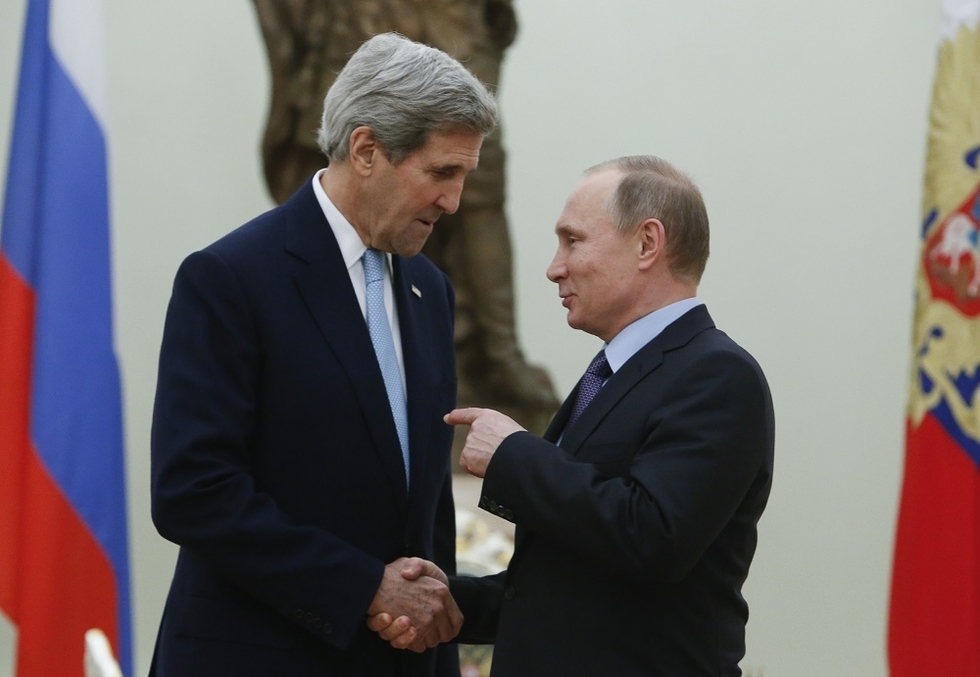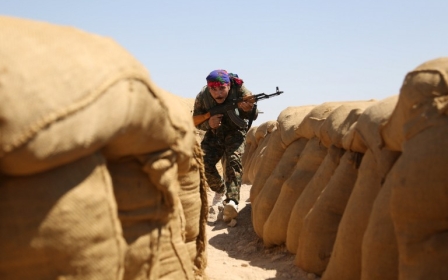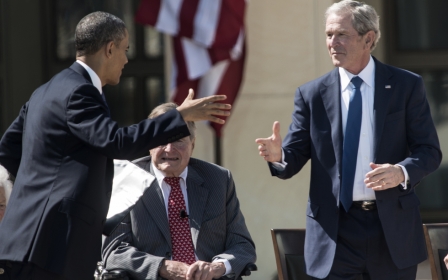Why Russia and the West can't win in Syria

Ever since the Soviet Union fell, Russia and the US have had an asymmetric relationship. In all its moods - the pendulum has swung from craven pro-Westernism to hostile nationalism - the Russian foreign policy elite has never stopped giving finger-wagging lectures to Western audiences. Russia's sense of betrayal runs deep because being European is part of its identity.
The asymmetry of this discourse is clear: the West has walked out of the lecture theatre. Successive US presidents have mouthed formulas (that they do not believe) saying that Russia is a great power. But they have no hesitation in tearing up treaties with it. Washington treated Ukraine as a European issue, and the US is far more concerned about Beijing’s ambitions in the South China Sea.
An inattentive partner can often do more harm than a hostile one. A leader like Vladimir Putin, who taps the well of lumpen Russian nationalism (the sort expressed by the FC Lokomotiv player at a Europa league match in Turkey), needs other strategies to get noticed on the international stage. The missiles Kim Jong-un fires into the air remind neighbours that North Korea exists.
Putin has achieved this effect in Syria. In a few short months, Russian air strikes have tipped the balance of power between government and rebel militias, assassinated rebel leaders, and attempted to dictate who is a legitimate Syrian rebel and who is not. Russia has forced its way into the international coalition against the Islamic State (IS) group and reinforced its seat at every international forum on Syria.
When talking Syria, US Secretary of State John Kerry now has to confer regularly with the Russian Foreign Minister Sergei Lavrov, whether he believes Lavrov, or indeed the head of Russian military intelligence, has any leverage over Syrian Presiden Bashar al-Assad or not. They probably do not.
The result is that Arab leaders have started to pay their respects to Moscow. First came Egypt, Jordan and the United Arab Emirates (UAE). Then in January came the Emir of Qatar. Bahrain's King Hamad bin Isa al-Khalifa followed by presenting Putin with a "sword of victory” made from Damascus steel. Putin invited his guest to ski with him on the slopes above Sochi. Hamad may not have been aware that this was the graveyard of another Muslim people wiped out by Tsarist Russia, the Circassians. He declined, anyway.
In Syria, Putin has regained the foothold in the Middle East that was previously abandoned when his prime minister, Dmitri Medvedev, acquiesced to the NATO-backed intervention in Libya.
This, then, was Putin’s entry strategy. What is his exit strategy?
As the US will be the first to tell Russia, the First Law of Foreign Intervention goes like this: If you break a country, you own it. If Russia enters as an active combatant, it owns the mess it inherits.
Putin is inheriting a country where 28 percent of the population now lives in camps abroad in Turkey, Lebanon and Jordan. He inherits a civil war entering its sixth year, which has created more civilian deaths and casualties than occurred after the US invasion of Iraq. He inherits a landscape in which hardline religious militancy is firmly rooted. He inherits responsibility for the barrel bombs a minority regime drops on its Sunni-majority civilians, dispatching waves of refugees to the borders. Jordan is a Russian ally, and yet it is bearing the brunt of the human misery Russia is generating. At the rate at which civilians are fleeing the government offensive, half the population could soon be outside the country.
What are the immediate prospects of a ceasefire in these circumstances? Nil. What are the prospects of reconciliation between Sunni and Shia? Ask me again in 10 years.
A united Syria is the least likely outcome of the huge physical pressures being exerted on it. At best, Syria will fragment into three enclaves: A Kurdish state in the north, an Alawite state in the West and a vast Sunni desert hinterland, from which attacks will be launched using a limitless reserve of volunteer suicide bombers. By clearing a path for Assad's forces, Russia is breaking Syria up into the small pieces that Libya has become.
This map of Syria is not an accidental outcome of a war that has lasted five years. Nor is it the exclusive consequence of the arrival of hardline fighters in IS and al-Nusra Front. It is the natural extension of the strategy Assad used to combat what started out as multi-faith protest movement.
Multi-faith? Indeed it was. It is forgotten now, but the slogan of the March 2011 protests was: “God is one and the Syrian people are one.”
Michel Kilo, a Christian Syrian dissident from Latakia exiled in Paris recounts how the Christian community reacted to events in Daraa in 2011:
“At that time the revolution was in its spring. It was peaceful. It took the shape of a national festival, a sort of Eid. Everyone participated in it, in increasing numbers, although the regime started using live fire against the protesters. The majority of the protesters were youths. It is what you would call civil society. Christians took a different direction. The youth were with the revolution, middle-class Christians were neutral or undecided and the church leaders were in numbers with the regime. One of the deputies of the Patriarch called the intelligence apparatus to arrest the youths who had come to his office to protest about the church’s stance. This was in spite of the fact there was nothing to show at the time that the Orthodox clergy were pro-regime. The Catholic and Maronite clergy were with the regime, although they were always complaining that the regime was forcing them to take a clear stance in their favour.”
A friend and confidant, Kilo attempted to persuade the then Orthodox patriarch to change sides: “We had a good relationship. He asked me to give him monthly briefings about the situation in Syria. When I was arrested, he called Bashar al-Assad and demanded my release. And he said to my wife: ‘One party sees nobody but himself. We are all prisoners of Bashar.’ This is what he said. I told him that Syrian society would go with the Arab Spring and that it was imperative for the Church to take a stand against violence and to call for a solution and to prevent a prolonged crisis, because the regime decided to use violence against the people.”
“I asked him: ‘Your Honour, if Jesus Christ were here now, on whose side would he be? Would he be in a tank killing people, or would he be among the demonstrators calling for freedom? If you can’t defend the freedom of the Syrians, you should stand down.’ Sadly the leadership of the church did not.”
George Sabra, a Greek Orthodox Christian and the first president of the Syrian National Council, Burham Ghalioun, a Sunni chairman of the Transitional National Council, and Fadwa Soliman, an actress of Alawite descent, were the pre-sectarian faces of the Arab Spring in Syria.
The cross-community appeal of the protest represented an existential threat to the Baathist regime. Assad deployed every means available to him to sectarianise the opposition. As has been well documented, he let out hardline militants from Sednaya Prison, whose ranks were augmented in a mass prison escape two years later from Abu Ghraib in Iraq. When Idlib was overrun by al-Nusra Front, Assad’s air force bombed the Christian community there, as is documented in this clip. He used the shabiha, Alawite armed militias, to commit sectarian atrocities against Sunni villages. Iranian militias and Hezbollah completed the job of turning a national conflict into a sectarian one.
Assad’s strategy worked. He created the landscape in which he could survive, but in which Syria's unity was sacrifised. That was the price everyone paid.
For hardline religious militants, Syria is a dream come true. A broken land, limitless reserves of disenfranchised Sunnis, division, and the forces of the whole world pitted fruitlessly against you. And here comes the fundamental mistake Putin and the Iranian Revolutionary Guard Corps have made in committing their forces to fight in Syria.
The conflict is not about territory and will not be solved by partition. It is about authority, identity and who represents and protects Sunni Muslims. Neither Russia nor Iran has an exit strategy from this. One represents Christian Orthodoxy and the other a fundamentalist Shia theocracy. Neither has authority nor the permission to dictate what Arab Sunnis do in their own land. They will always been regarded as foreigners, and will receive the same treatment that other invaders before them know only too well.
- David Hearst is editor-in-chief of Middle East Eye. He was chief foreign leader writer of The Guardian, former Associate Foreign Editor, European Editor, Moscow Bureau Chief, European Correspondent, and Ireland Correspondent. He joined The Guardian from The Scotsman, where he was education correspondent.
The views expressed in this article belong to the author and do not necessarily reflect the editorial policy of Middle East Eye.
Photo: US Secretary of State John Kerry (L) and Russian President Vladimir Putin shake hands (AFP)
Middle East Eye propose une couverture et une analyse indépendantes et incomparables du Moyen-Orient, de l’Afrique du Nord et d’autres régions du monde. Pour en savoir plus sur la reprise de ce contenu et les frais qui s’appliquent, veuillez remplir ce formulaire [en anglais]. Pour en savoir plus sur MEE, cliquez ici [en anglais].





